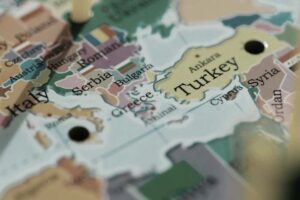
One of the most unusual and mysterious terror attacks in Israel’s history took place in the early hours of April 30, 2003. That evening, security forces were on a desperate manhunt for foreigners planning a suicide bombing in Tel Aviv.
The Shin Bet only had a general warning about an imminent attack. The agency deployed its operatives on city streets to search for suspicious tourists at potential targets. But the hunt failed.
After midnight, two British citizens of Pakistani origin were ready to strike. Asif Mohammed Hanif and Omar Khan Sharif left their small hotel in central Tel Aviv and headed to the beachfront promenade. They decided to blow up Mike’s Place, a popular bar near the American embassy.
At the site, a security guard suspected the bombers. A struggle ensued as one of them, Hanif, tried to rush into the club. He triggered his explosive belt outside, killing three people and wounding many others.
The second bomber, Sharif, was unable to detonate his explosive, so he escaped on foot. He tried to force his way into a hotel and to take over a taxi but both attempts were rebuffed. Then, he disappeared.
The security services launched a massive search and soon found the explosive belt, but no sign of Sharif. Two weeks later, his body was found on a Tel Aviv shore. He apparently drowned, but the exact circumstances of his death were unclear.
There was some speculation that he was captured by Israel and killed after an interrogation, but no proof of this ever emerged.
Unusual explosive belt
The Israeli investigation revealed some information, but other details remain unknown — or possibly unpublished — to this day.
Security forces raided the bombers’ hotel room hours after the attack. They found shaving gear and other items suggesting that the Muslim attackers performed a strict cleansing ritual before embarking on their death mission.
Investigators also recovered a map of Tel Aviv where the terrorists marked some locations, including Mike’s Place, and added comments in English.
Israel’s intelligence agencies believe that the attack was planned by Hamas, but some question marks remain about possible connections to foreign terror cells. There were later suggestions that subsequent bombings in London were related to the Tel Aviv attack.
The probe revealed that the bombers likely received the explosives in the Gaza Strip and crossed into Israel in the car of an Italian journalist. But this, too, appeared to be an unconfirmed estimate. Ever since then, journalists coming out of Gaza undergo a strict search by security officers.
Another question mark pertains to the high-powered and unusually sophisticated explosives. These were normally used by professional armies or intel agencies and not by Palestinian terrorists. The exact origin of the devices apparently also remains unknown.
The security guard who averted a much larger disaster, Avi Tabib, miraculously survived the blast and recovered fully despite grave injuries. He later launched a speaking tour to share his story with others. The bombing also inspired a documentary film titled Blues by the Beach.
Overall, more than 100 suicide bombings were carried out against Israelis in the 1990s and 2000s by Palestinian terrorists. None of them resemble the 2003 Mike’s Place attack in Tel Aviv.
- READ MORE: Israel’s Secret Intelligence Machine


